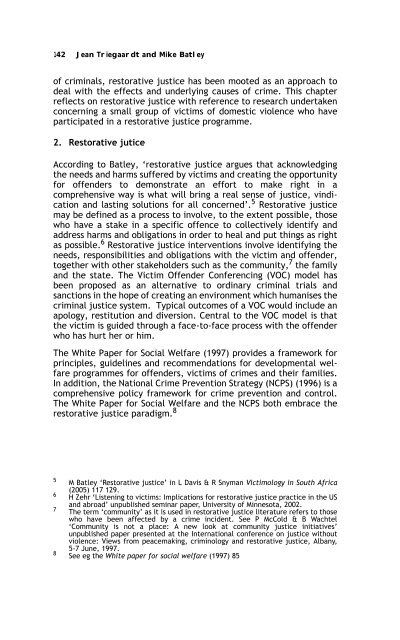Sex, Gender, Becoming - PULP
Sex, Gender, Becoming - PULP
Sex, Gender, Becoming - PULP
Create successful ePaper yourself
Turn your PDF publications into a flip-book with our unique Google optimized e-Paper software.
142 Jean Triegaardt and Mike Batley<br />
of criminals, restorative justice has been mooted as an approach to<br />
deal with the effects and underlying causes of crime. This chapter<br />
reflects on restorative justice with reference to research undertaken<br />
concerning a small group of victims of domestic violence who have<br />
participated in a restorative justice programme.<br />
2. Restorative jutice<br />
According to Batley, ‘restorative justice argues that acknowledging<br />
the needs and harms suffered by victims and creating the opportunity<br />
for offenders to demonstrate an effort to make right in a<br />
comprehensive way is what will bring a real sense of justice, vindication<br />
and lasting solutions for all concerned’. 5 Restorative justice<br />
may be defined as a process to involve, to the extent possible, those<br />
who have a stake in a specific offence to collectively identify and<br />
address harms and obligations in order to heal and put things as right<br />
as possible. 6 Restorative justice interventions involve identifying the<br />
needs, responsibilities and obligations with the victim and offender,<br />
together with other stakeholders such as the community, 7 the family<br />
and the state. The Victim Offender Conferencing (VOC) model has<br />
been proposed as an alternative to ordinary criminal trials and<br />
sanctions in the hope of creating an environment which humanises the<br />
criminal justice system. Typical outcomes of a VOC would include an<br />
apology, restitution and diversion. Central to the VOC model is that<br />
the victim is guided through a face-to-face process with the offender<br />
who has hurt her or him.<br />
The White Paper for Social Welfare (1997) provides a framework for<br />
principles, guidelines and recommendations for developmental welfare<br />
programmes for offenders, victims of crimes and their families.<br />
In addition, the National Crime Prevention Strategy (NCPS) (1996) is a<br />
comprehensive policy framework for crime prevention and control.<br />
The White Paper for Social Welfare and the NCPS both embrace the<br />
restorative justice paradigm. 8<br />
5<br />
M Batley ‘Restorative justice’ in L Davis & R Snyman Victimology in South Africa<br />
(2005) 117 129.<br />
6 H Zehr ‘Listening to victims: Implications for restorative justice practice in the US<br />
and abroad’ unpublished seminar paper, University of Minnesota, 2002.<br />
7 The term ‘community’ as it is used in restorative justice literature refers to those<br />
who have been affected by a crime incident. See P McCold & B Wachtel<br />
‘Community is not a place: A new look at community justice initiatives’<br />
unpublished paper presented at the International conference on justice without<br />
violence: Views from peacemaking, criminology and restorative justice, Albany,<br />
5-7 June, 1997.<br />
8 See eg the White paper for social welfare (1997) 85
















